Bird symbolism in Chinese art 鸟 niǎo
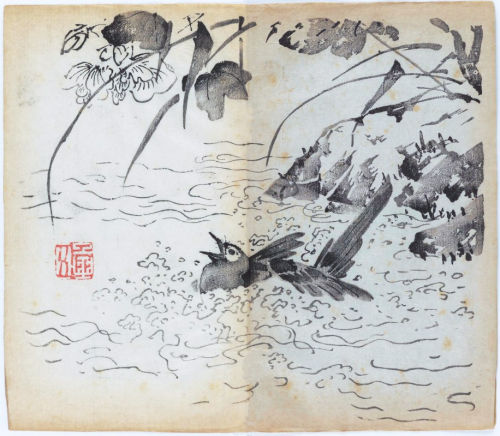
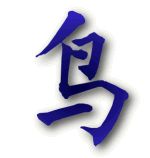
Specific birds give hidden meanings in Chinese paintings, individual entries in this section include magpies, quails, swallows, cranes, ravens, eagles and many others. Chinese Birds may visit and help the virtuous but there may also be birds of ill omen including owls and crows. The character for bird neatly represents a perched bird 鸟 as an ancient pictograph. The Chinese phoenix is considered the representative of all feathered creatures. Care must be taken in speech as the character for bird niao is also used as an expletive! ➚
Here are birds and their symbolism in Chinese art:
Cockerel 公鸡 gōng jī
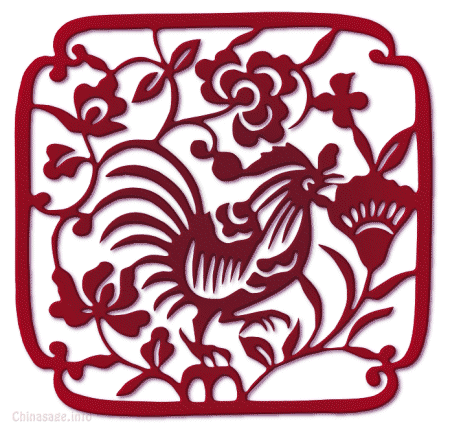
The cockerel or rooster is an honored creature in China. It is one of the twelve animals forming the Chinese zodiac. Out of reverence, the cockerel in contrast to hens, was not killed for meat. Cockerels are valued for ravenously eating insect pests. They are seen as fierce, wise, courageous, benevolent and loyal. It is lucky because it sounds the same as 吉 jí ‘auspicious, lucky’. A figure of a red cockerel is often seen as a figure on the ridge of roofs in the belief that because it is a ‘fire’ creature it will keep fire under control (as well as demons). It is associated with yang, the sun and summer. Some say that the bird at the center of the sun is a three-legged cockerel rather than a raven. A picture of a cock crowing (公鸡鸣 gōng jī míng) symbolizes achievement. The cock's comb 冠 guān uses the same character as for the hat of an official and and so symbolizes a wish for an appointment as an official.
Cock fighting ➚ was once a very common sight in China as elsewhere in the world. Cockerels were also trained to herd ducks in olden days.
A chicken 鸡 jī is given the character of a ‘bird’ in a ‘hand’ showing its long domestication, however the old form of jī 雞 used as the phonetic a combination of adult producing silk signifying a woman in another form of domestication. However calling a woman a hen is unwise as jī is a slang word for a prostitute.
Crane 鹤 hè
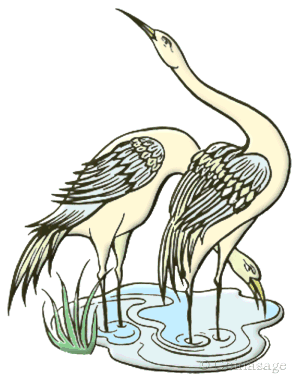
The graceful crane is a common emblem in paintings. The name 鹳 guàn is used for the similar looking storks and the same symbolism applies. Storks tend to live in wetlands while cranes prefer drier areas. Like pine trees and stones, the crane symbolizes longevity as well as wisdom. It is fabled that when a crane reaches 600 years old it no longer needs to eat. It stands as a homophone for 合 hé ‘peace, harmony’. An embroidered crane formed part of the regalia of the fourth Imperial grade of Imperial officials. ‘Guan’ sounds the same as 官 guān ‘official’ and 冠 guān ‘hat, first place’ so can symbolize the wish for job promotion. A crane is often portrayed with a tortoise (longevity) or a deer (longevity and riches). A stork also often accompanies the important folk deity the Queen Mother of the West. Traditionally there were said to be four types of crane: white, black, white and blue.
The five birds: crane, phoenix, mandarin duck, heron and wagtail represent the five Confucian relationships; in this case the crane stands for the top grade of deference - that should be shown by a son to his father. Two cranes flying towards the sun represent ambition. A crane among clouds represent nobility; a pair of cranes represent a wish for long married life while a crane in a pine tree is a wish for a long life together (松鹤同春 sōng hè tóng chūn ‘grow old together as if in spring’).
The modern character for flight (飞 fēi ) is just one wing but the traditional form of this character is 飛 which may represent a crane in flight with two ‘wings’ and a long neck.
A Daoist master was said to be able to transform into a crane. A figure of a crane was sometimes included in a funeral procession to represent the ascension of the soul to paradise which was carried by a crane. In mythology, the ‘boy of the white crane’ is a messenger of the gods who helps heroes.
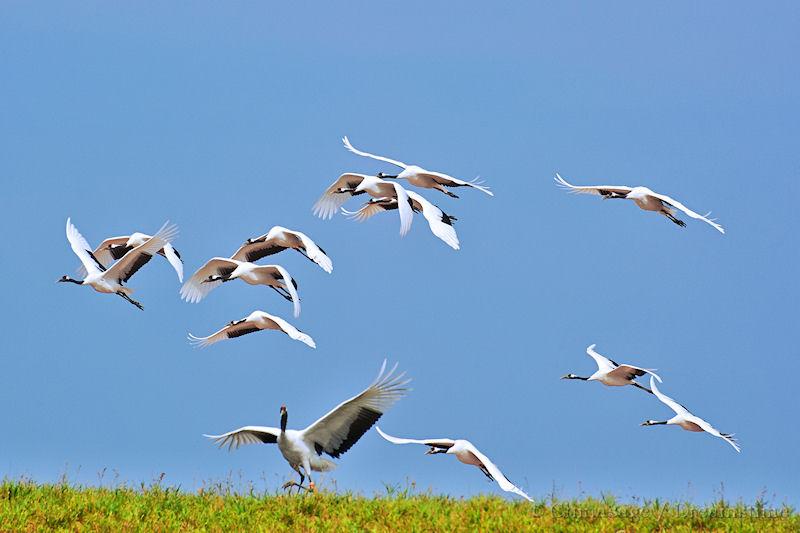
Crow 乌鸦 wū yā
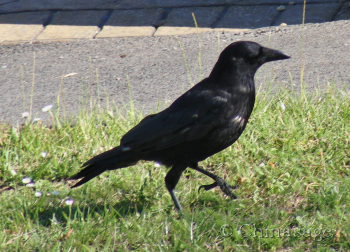
The Chinese name of the crow comes from its raucous call, which was considered an ill omen, particularly if heard when a deal was being negotiated. Its call is similar to 咬 yǎo the word for ‘bite’. Young crows help their parents bring up the next brood. The Chinese, long before bird ringing came along, were able to accurately observe this and so the crow stands as a natural example of faithfully serving parents.
The character for crow 乌 wū is very similar to the one for bird 鸟 niǎo . All that is different is a missing stroke to represent the eye, which, because a crow has a black eye that is not seen against its black plumage. The crow is used as a symbol for the sun as a red, three footed crow (or raven) was believed to rule it. There is an ancient Chinese proverb that says ‘it is better to be an honest crow than a deceitful magpie’.
Dove 鸽 gē
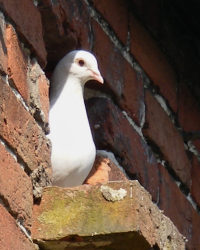
Rather than being associated with young love as it is in the west, the Chinese association of the dove is with long life and fidelity as doves pair for life. It is also revered for taking tender care of its young. A jade scepter 玉杖 yù zhàng with a figure of a dove at one end was given to people who reached the age of seventy which is why the scepter was also known as the ‘dove staff’ 鸽杖 gē zhàng.
In the countryside youngsters used to attach small wooden whistles to the tail feathers of doves and pigeons so that they gave out a whistle when they flew, just as they did with kites.
Duck 鸭 yā

Ducks when portrayed in pictures or on porcelain denote a wish for happiness, especially when combined with a lotus.
The Mandarin duck (鸳鸯 yuān yāng) is so named because of its self importance and flamboyant plumage like the high officials (掾 yuàn ‘mandarins’) of the Imperial court. Mandarins are native to China and nest in trees, the male is far more colorful than the female. It symbolizes loyalty as the ducks are said to mate for life and that when one dies its mate will pine away and also die (now known not to be true unfortunately). Often the mandarin drake is shown with a lotus flower in its beak and its mate with a lotus fruit with the meaning of a wish for children. They are a popular motif on wedding gifts. A mandarin duck and a butterfly together signifies unrequited young love. A duck amongst reeds 一甲连科 yī jiǎ lián kēgives the wish for good luck in examinations (a reed is a homophone for ‘passing exams’).
Ducks remain a very common farm animal. It was usually the girls of the household who looked after them and trained them to obey commands by whistles.
In Taiwan the rebel leader Zhu Yigui ➚ was called the ‘mother duck king’ because he was a duck breeder and on one occasion trained his ducks to march in step towards an enemy division. It is a something you have to be careful with as it is also a slang term for a homosexual.
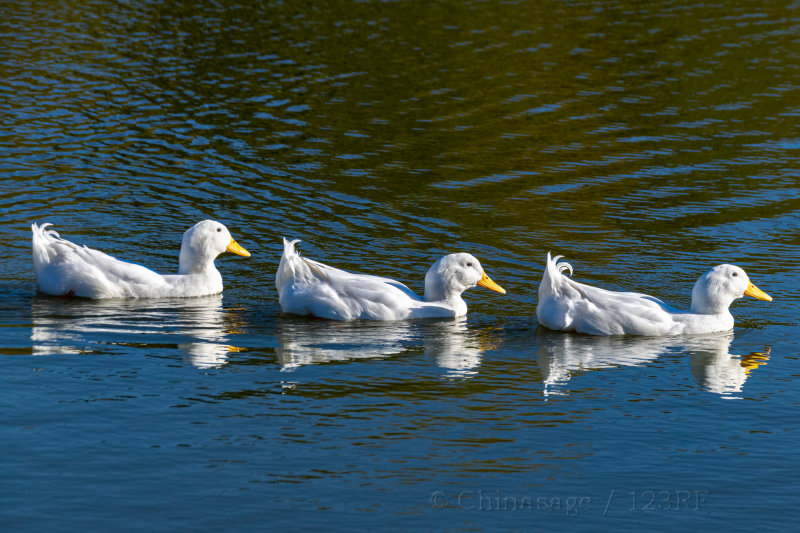
Eagle 鹰 yīng

The eagle is not widely seen in Chinese art, when it does it symbolizes strength. Eagle tail feathers were considered a potent charm. An eagle and bear together symbolize a hero 英雄 yīng xióng (英 yīng means ‘hero’ as well as ‘England’). The Daoist God of Thunder (Lei Gong) is half-eagle and half-man. An eagle in a pine tree wishes strength in old age; while an eagle on a rock symbolizes a lonely struggle.
Goose 鹅 é

A goose is a symbol of marital fidelity like the mandarin duck as it mates for life and often flies in pairs. An old tradition for marriage gifts reinforces this, the bridegroom's family was given a gander and the bride's family a goose. Wild geese are also a symbol of separation as they migrate south in winter.
The sage of calligraphy Wang Xizhi is often shown with a pair of geese of which he was very fond, it is believed that observing the graceful movements of geese influenced his writing style. A goose was used as the emblem of the Imperial Postal Service because of the story of Su Wu ➚ 苏武 who alerted the Emperor in 81BCE to his false imprisonment by tying a letter to a goose's foot.
Hawk 鹰 yīng
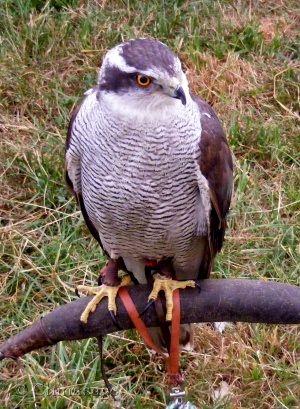
The character ‘ying’ can mean any one of several raptors: falcons, hawks and eagles.
The Mongol khans, in common with the people of Central Asia today, are very fond of falconry. Marco Polo, with his customary exaggeration, describes an excursion of Emperor Kubai Khan took 70,000 attendants with eagles large enough to take away wolves.
In decoration they symbolize boldness and keen sightedness.
Heron 鹭 lù
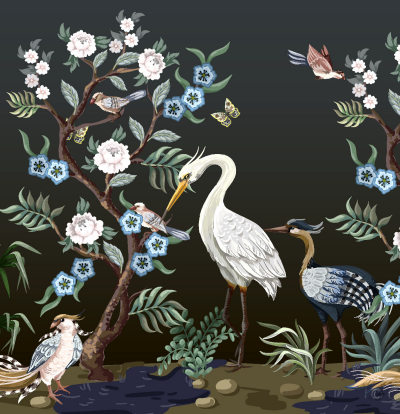
The heron often features in Chinese poems together with the marshes and lakes it likes to inhabit.
In a painting it symbolizes a path or way as it sounds the same as 路 lù ‘way, method or path’. If shown with a lotus then this adds the sentiment of progression as 莲 lián ‘lotus’ sounds the same as 连 lián ‘successive’ giving the phrase: 路莲升 lù lián shēng ‘May you follow a path of continuing promotion’.
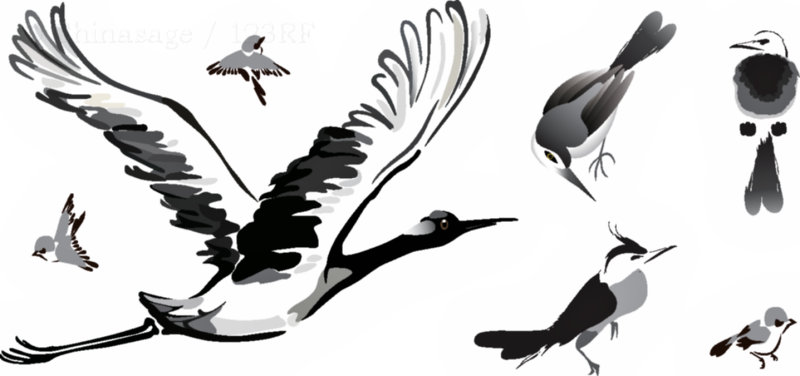
Kingfisher 翡翠 fěi cuì
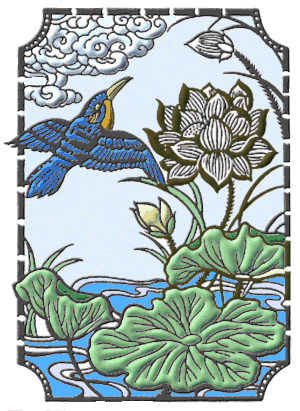
There are several species of Kingfisher in China that are all admired for their bright, iridescent plumage. The feathers have been used to create colorful artwork collages. The same character 翡 fěi is used for a type of green jade and probably from this it is a metaphor for the more showy forms of female beauty.
Magpie 鹊 què
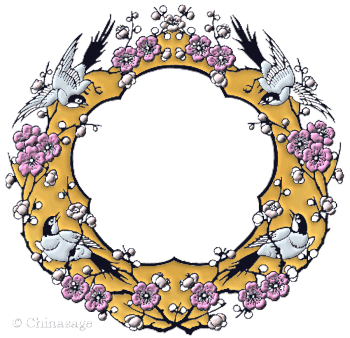
The magpie is universally admired for its intelligence and guile but it can be a nuisance to farmers. In China it has a positive connotation, a harbinger of joy and as such a magpie is used in paintings to wish someone joy as 喜 xǐ means ‘glad, joy and happiness’. If the character is shown upside down, like fu (good fortune), it means happiness is arriving.
The most famous legend associated with magpies is that of Zhinu 织女 and Niulang 牛郎 where on the 7th day of the 7th lunar month a bridge of magpies allows the two lovers to be briefly re-united among the stars. Another legend features a hand mirror broken in two so husband and wife could each take one half, if either party was unfaithful then the mirror turned into a magpie and flew back to the aggrieved partner. This is why magpies became a favorite decoration for the backs of mirrors.
If a magpie is heard while ruminating on an action it is considered a sign that the plan is the right one. The founding father of the Manchu dynasty is said to have been prevented from taking an unwise military action by a magpie landing on his head. There is also a legend that he was the son of a magpie. It is considered lucky if a magpie builds its nest near your home.
In pictures a group of magpies symbolizes many good wishes, with an official on horseback signifies ‘multiple joys’. Pictures with magpies, bamboos and plums signify a wish for marital joy. With plums 梅 méiit gives the message 喜上眉梢 xǐ shàng méi shāo ‘may happiness fill you up to the top of your eyebrows’. A pair of magpies symbolize marital bliss (double happiness). Rather curiously the character for ‘write’ in its traditional form is a magpie under a roof 寫 perhaps indicating that writing is setting ideas in order just as how a magpie arranges its nest (the simplified form is now 写 xiě).
Oriole 莺鸟 yīng niǎo
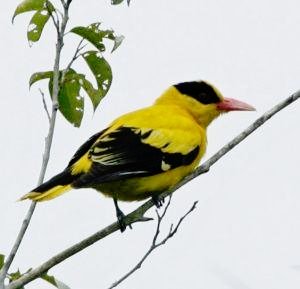
The oriole has a beautiful song and so is associated with joy. The bird symbolizes friendship when depicted in pictures. With peony and plum blossom it expresses a wish for joy to arrive in Spring. An association with young female beauty makes it also crop up in descriptions of prostitutes and brothels.
Owl 枭 xiāo

For Chinese people owls are birds of ill omen. One legend is that young owls only left the nest after pecking out the eyes of their mothers. Its large staring eyes were considered demonic and its call is frightening and in some dialects it sounds like the word for ‘digging a grave’. A dismissive metaphor for scandalous rumor was ‘a dog barks and an owl cries’. An owl's call was taken as a sign that someone had died and if it comes to rest on your house misfortune would likely follow. To stave off the associated ill fortune a picture of an owl was used as a talisman, often on roofs.
There is the story of Jia Yi ➚ [c.200-169BCE] who wrote an ode called 'On the Owl' 鵩鳥賦 in it Jia, who had been recently exiled from the Imperial court, asked an owl that had alighted on his house: 'Where is it I must go? Do you bring good luck? Then tell me! Misfortune? If so what disaster?! Must I depart from here so soon? Then tell me when?'. Superstitions concerning owls go back a long way!
There is another name for an owl in Chinese : 猫头鹰 māo tóu yīng which transliterates as ‘cat headed eagle’ which is a pleasingly descriptive name.

Parrot 鹦鹉 yīng wǔ
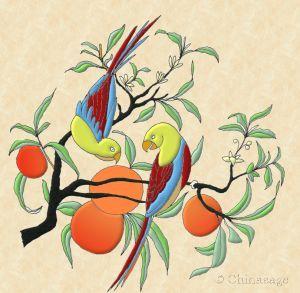
In China the parrot is only found in the wild in the southern provinces but has been kept elsewhere as a caged bird for thousands of years. For decoration it is mainly used as a colorful motif on porcelain.
Its talkative nature is presumed to keep wives faithful in Guangxi as a parrot could possibly give the game away; perhaps from this it became to be a symbol for a loose woman. A parrot is often associated with the Buddhist deity Guanyin holding a pearl in its beak. The word for parrot can also mean a young girl.
Peacock 孔雀 kǒng què

The handsome male peacock struts around showing off its amazing ‘eyed’ tail feathers to seek the admiration of a passing peahen. It is an emblem of beauty and dignity. In the Ming and Qing dynasties the seniority of officials could be judged by the number of peacock feathers he wore in his hat. So peacocks in decoration can represent the wish to become an official.
The Queen Mother of the West is sometimes depicted riding a peacock or with peacock feathers in her hair. There is a legend of a beautiful daughter who set a challenge to select the man to marry her. She painted a peacock on a screen and the first Tang Emperor Gaozu won her hand by shooting an arrow through both eyes of the peacock in the painting this led to the phrase “choose by hitting the screen of birds” which expresses the wish to catch an ideal partner.
Peng Niao 鹏鸟 péng niǎo
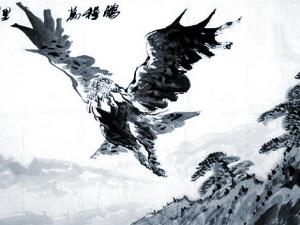
The Peng niao is a legendary bird of immense proportions rather like the mythical Ao giant turtle. Its huge wings allow it to swoop thousands of miles. In the “Divine Classic of Nanhua” ➚ Zhuangzi describes the giant bird that dwarfs the mountains. It is said that a giant Kun fish turned into the Peng Niao. The bird symbolizes rapid advancement due to its immense speed and size. The bird is mentioned in the 1,000 character classic.
Pheasant 野鸡 yě jī
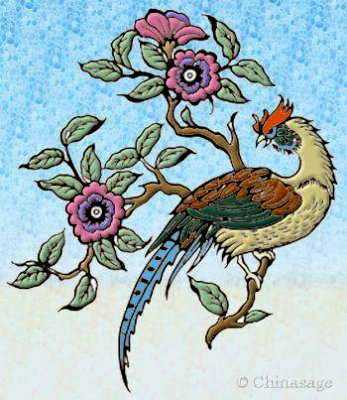
The pheasant, bred for game shooting in the UK and elsewhere, comes from China. There are several different pheasant species often with the males having spectacularly colored plumage. Pheasants are sometimes interchanged with phoenixes as emblems of beauty and good fortune.
Some tales make it a bird of ill omen, if it did not call in the twelfth lunar month floods would arise. Other tales have pheasants over-wintering as an oyster (as with the swallow). Two grades of Qing dynasty officials had a pheasant decoration to indicate their rank. It is one of the twelve Imperial insignia and sometimes, like the phoenix, represents the Empress.
Phoenix 鳯凰 fèng huáng

The phoenix is such an important bird in Chinese symbolism that we have a separate section dedicated to this bird Read More.... The phoenix and dragon are often paired, the dragon representing the emperor and yang while the phoenix the empress and yin. And so the dragon and phoenix together represent the harmony of a married couple. To use the English name ‘phoenix’ is rather misleading as there is little in common with the Egyptian mythical bird ➚. There is no legend in China about reincarnation from ashes. In China the phoenix was a wind god. The vermillion (red) phoenix represents the most important of directions - south. The phoenix on its own is a symbol of joy and peace, it heralds the coming of auspicious days just like the qilin. The Manchu conquest was apparently heralded by the appearance in Henan of a phoenix.
Quail 鹌鹑 ān chún

The quail is a ground nesting bird like the partridge and the pheasant. Cock quails will fight each other and betting on quail fighting was common in China like cock-fights elsewhere in the world. The fighting quality makes them an appropriate symbol for courage and a fighting spirit. They are believed to mate for life and so signify marital loyalty. Another association is with the hard study of a scholar. In a picture a quail may symbolize peace as 安 ān sounds the same as ‘quail’. Nine quail with chrysanthemums symbolizes a wish for many generations to live long together in peace.
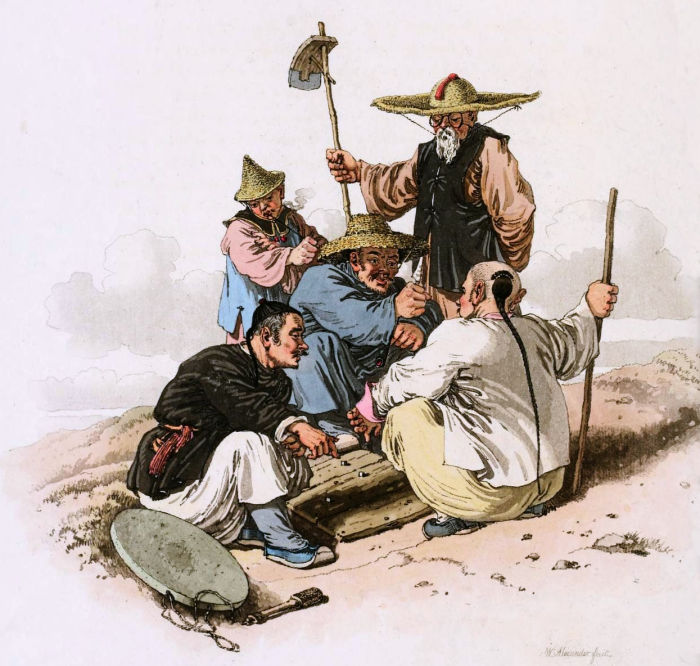
Raven 乌鸦 wū yā

The raven is a large, intelligent black bird. For some reason it is also the bird in the center of the sun (other legends have this as a crow or cockerel) and this raven has three legs. This celestial raven is a messenger of the Queen mother of the West (Xi Wangmu). A creation legend has it that there were ten sun-ravens in the sky creating far too much heat, so the Divine archer Houyi shot down nine of them. The emblem of the ancient Zhou dynasty was a red raven and the Manchu people fed ravens in the belief that they were the spirits of their ancestors.
It has been observed that corvids, including ravens, crows and magpies, play tribute to their dead ➚. This may explain why they are considered pious and legend says that ravens build burial mounds for distinguished people. Like the crow, to hear the croak of a raven is generally unlucky but at particular times of day it can be auspicious.
Swallow 燕子 yàn zi
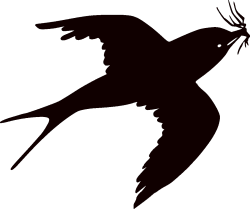
The swallow is depicted as a character complete with a wing, head, body and tail. They used to be very numerous in China as the traditional roofs offered ideal nesting places. Beijing was known as the ‘Capital city of Swallows’ 燕京 yàn jīng.
The coming of swallows in spring was welcomed and signified good luck for the household. This may be linked to their amazing nest building skills, they can quickly repair and build a structure just out of mud. To account for their disappearance in winter, there was a legend that swallows spent the time transformed into mussels by the sea. In Europe it was believed that they hibernated ➚ - some say under water.
The Chinese delicacy Bird's nest soup ➚ is made from seaweed and the dried saliva of the sea swallow (Hirundo esculenta).
Poetically the sound of women’s voice is likened to the twittering of swallows and the fragile nest is a metaphor for transience and instability. A swallow may also signify brotherly affection.